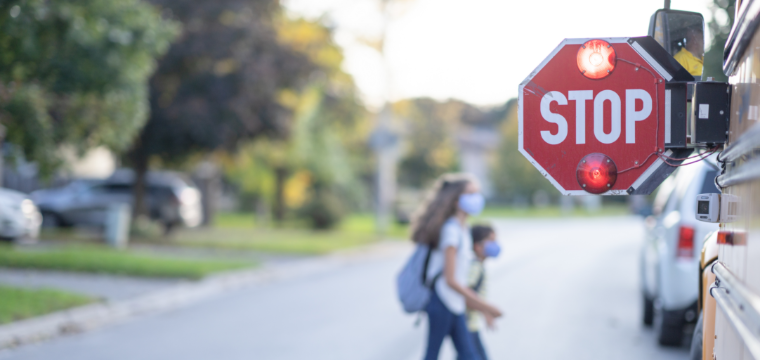Needless to say, we are all concerned about the safety of our youth, especially when they hop on a school bus. School bus laws are stringent to protect the safety of children being picked up or dropped off throughout the school year. Once school starts, we see two prominent perspectives on road safety emerging from those stopping for school buses and parents trying to promote school bus safety. As personal injury attorneys, we believe that the utmost care should be taken on the roads. Here is our outline for safety considerations at both ends of the spectrum.
Missouri School Bus Laws
Missouri statute requires school buses to maintain certain safety standards. For one, school buses must have text that visibly designates them as a “school bus” in letters no less than eight inches in height. They must also have lettering that states “State Law: Stop while bus is loading and unloading.” Apart from text, each bus is required to have a crossing control arm affixed to the front bumper that extends five feet six inches in front of the bus. This control arm is used to promote school bus safety where children cross, making them cross multiple feet in front of the bus so that the driver can alway see them. Finally, each school bus has extendable stop signs on their sides so motorists can be certain when it is time to stop.
Some drivers may wonder if they really need to stop for the bus if they are in another lane — the answer is likely yes. On a two-lane road, both lanes of traffic must stop for the bus. However, on larger roads, the bus stop signs control traffic in the lane the bus is traveling. There are two highway scenarios concerning school bus safety: divided highways and undivided highways. On a divided highway, both lanes traveling the same direction would have to stop as soon as the bus does, while the traffic going the opposite direction would not need to stop. However, undivided highways would require all lanes of traffic to stop, regardless of their direction.
For Drivers Stopping for School Buses
Missouri law expects you to exercise the highest degree of care when driving. As with most personal injury cases, this means you must act as a very careful person would under the same or similar circumstances. As a motorist, you must keep in mind that you are sharing the road — those who fail to stop for school buses can incur multiple types of liability.
If you fail to practice school bus safety or watch for children, you incur civil liability for any harms and losses the involved parties experience. This could include striking a child on the road or injuring the children and bus driver on the bus. Those who fail to stop for a school bus may incur criminal liability — it can be considered reckless driving to blow past a stop sign, a misdemeanor charge that comes with fines and possible jail time.
When it comes to civil repercussions, there are multiple parties that may bring legal action against you. If you injure a child, their parents or guardians may bring suit on behalf of the child for the medical expenses incurred and compensation for the injuries suffered by the child. If you strike a bus, you may also face suit from the school district and the driver. School districts may file suit for the property damages you caused to the bus, and if injured, a bus driver may file a case for the cost of their medical expenses and those personal injuries they experience.
Our personal injury attorneys’ best advice is to drive with proper consideration for school bus safety — we recommend that when stopping for school buses you:
- Allow plenty of room to stop.The ideal stopping distance is multiple car lengths from the bus.
- Be patient. Do not pass the bus, especially at a high speed. When the stop signs are active, slow your speed, stop and wait until the bus continues moving before moving your vehicle again.
- Watch for children. Be prepared for children to be walking along the shoulder, crossing the street or not being a safe distance away. Regardless of where the child is walking, you would be held accountable for the damages involved with striking them.
- Be prepared to stop. School buses stop often, so expect to stop multiple times while you are behind them.
For Parents Promoting School Bus Safety
Children are often not concerned with school bus safety on their own — they must be taught by their parents to take care around roadways and motor vehicles stopping for school buses. If you are a parent, you must consider discussing safety on school buses with your child before the school year begins. We recommend explaining bus safety in terms of the following stages.
- Waiting for the bus. It is a good rule of thumb for a child to remain two large steps away from the curb until the bus comes to a complete stop. This means they should not stand in the gutter or directly on the curb.
- Boarding the bus. A child should not start moving forward until the bus has fully stopped and the doors have opened. When a child approaches the bus door, they should use the handrail to climb the steps. This is especially important if the child is young or particularly short.
- Riding the bus. When promoting school bus safety, you should advise your child to take their seat and do not move until the bus has fully stopped at the destination.
- Leaving the bus. When leaving the bus, a child should try to stay at least five good steps in front of the bus before they cross the street. The idea is that they should be able to make eye contact with the bus driver to make sure that they can see them. This way, the child remains safe from the school bus as well as those stopping for school buses.
Regardless of your designation, school bus safety is of paramount importance this school year. If you have been involved in a school bus accident, contact an automotive accident attorney to help start your case. Otherwise, check out our legal & safety blog for more tips on road safety this back-to-school season.









